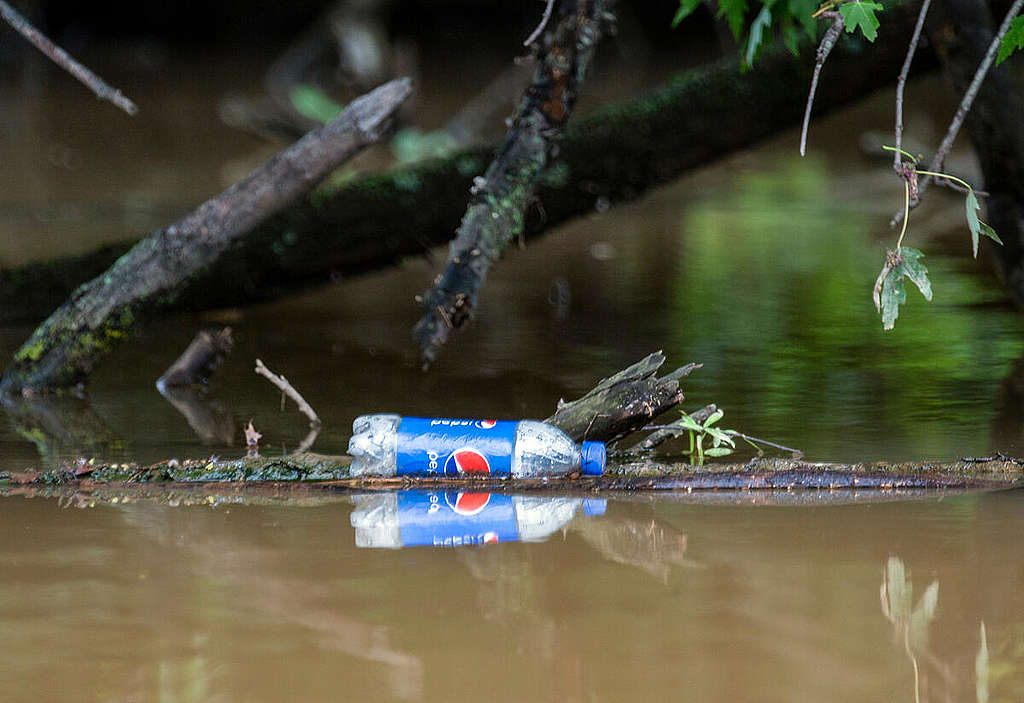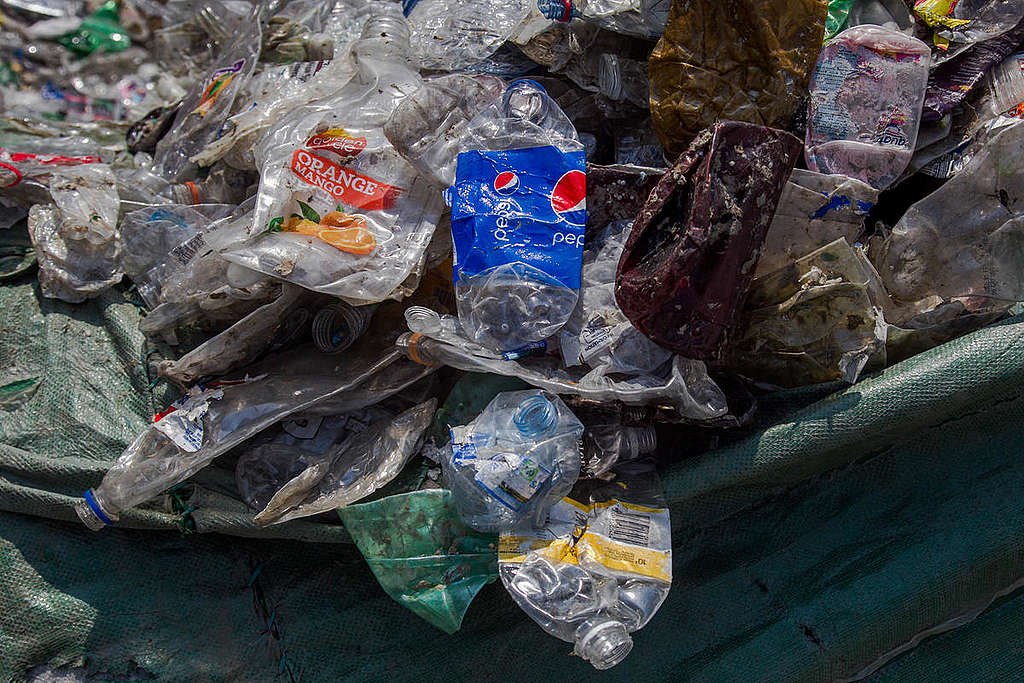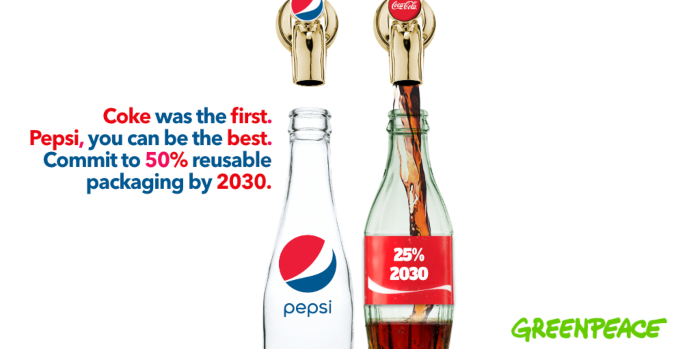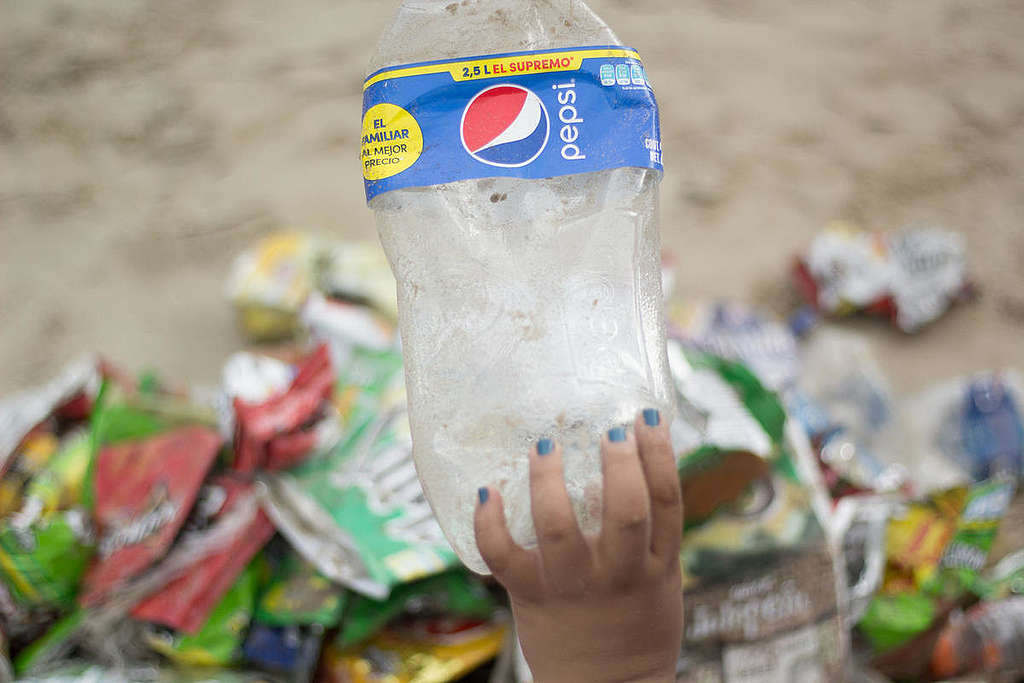Coca-Cola recently committed to making 25% of their packaging reusable or refillable by 2030 – can Pepsi rise to the challenge and be more ambitious than Coke?

Coke or Pepsi? Many soda drinkers around the world where both options are available have strong loyalties to one or the other and the rivalry between the two beverage companies is more than a century old.
In the 1970s, Pepsi launched the "Pepsi Challenge" which invited consumers to guess which cola they prefer in a blind taste test. This year, I want to challenge Pepsi to step up in the fight to stop single-use plastics from polluting our world and to be more ambitious than Coca-Cola.

It's time to demand that massive consumer goods companies like Coca-Cola, Nestlé, PepsiCo, and Unilever reject unnecessary throwaway plastics.
Personally, I don't drink much soda, but I spend most of my days thinking about Coca-Cola, Pepsi and the way that these companies deliver their products to soda drinkers.
The unfortunate truth for both brands is that most of their products come in single-use containers, oftentimes made of plastic, that we use for just a few minutes and then throw away (or attempt to recycle if we live in an area with recycling infrastructure). This method of distributing soda is unsustainable, energy-intensive, polluting our communities and contributing to climate change.
The video that @cocacola, @nestle and @pepsi don't want you to see
If industry has its way, plastic production could double by 2030.
Sign our petition to end-single plastic and make the big brands switch to refill and reuse >> https://t.co/9wXIcCFU0W#BreakFreeFromPlastic pic.twitter.com/cjsBSXW6gY
— Greenpeace (@Greenpeace) April 8, 2021
For the past four years, Coca-Cola, PepsiCo, Nestle and Unilever have been named the top plastic polluters in global brand audits. Their plastic waste can be found everywhere – in the food we eat, in our drinks, in the air we breathe, scientists even found microplastics in our blood and our lungs.
Attempting to increase the recycled content of their plastics - the gist of their plastic waste strategy until very recently - will not prevent these companies from polluting our communities, wrecking our climate and natural spaces.
In February, Coca-Cola committed to making at least 25% of their packaging reusable or refillable by 2030. This is the first time that a Big Brand has made any sort of commitment on refill and reuse metrics. Reuse and refill systems are nothing new - think of the milkman delivering bottles and collecting the empty ones to be cleaned and reused, or think of how you used to be able to buy a soda in a glass bottle, then return the bottle so that it could be used again.
Coca-Cola states that 16% of its packaging is already refillable and reusable, mostly in Latin America. They've got a long way to go before they can be a real leader in the fight against plastic pollution, but they're currently leaps and bounds ahead of Pepsi.
@CocaCola your shareholders' meeting is taking place today and WE WANT ACTION!
You are one of the biggest plastic polluters and we want solutions that match your contribution to the problem: 50% reuse and refill by 2030.https://t.co/NNJsW2HhBm#Refill #Reuse pic.twitter.com/oOPgEmZyY8
— Greenpeace (@Greenpeace) April 26, 2022
So, let's bring this back to Pepsi. Pepsi's current amount of reusable or refillable packaging? Zero. Yep, you heard it – a whopping 0% of Pepsi's packaging portfolio includes reuse and refill. But, there is a small glimmer of hope – in March, shareholder non-profit AsYouSow announced that Pepsi pledged that they would set a refill & reuse goal by the end of 2022.
This announcement-to-make-an-announcement begs several questions: How quickly will Pepsi aim to move a portion of their packaging to reusable systems? How ambitious will their commitment be? And of course, will Pepsi go above and beyond Coke's commitment of 25% by 2030?
Pepsi has a huge opportunity to beat their long-time rival at something that many of us are ready for. People are extremely concerned about the plastic pollution crisis and climate change – and the two are very interconnected. Will Pepsi seize this moment and beat Coke in the refill and reuse race or will they come out with a weak commitment that underwhelms and disappoints us at the end of 2022?

The path to a world with reuse and refill might not be the easiest one – it will require buy-in from customers, refill/reuse infrastructure, policy changes, and even collaboration among big brands like Coke and Pepsi – but we know it is necessary if we are going to stem the tide of single-use plastics flowing into our oceans every day. It might not be the easiest thing to do, but it is necessary. The plastic problem is vast, it impacts all of us, and it is time for the multi-billion dollar corporations who caused this crisis to actually do something to fix it.
With our collective voices pressuring PepsiCo leading up to their Annual Shareholder meeting in May and throughout the remainder of the year, I am hopeful that Pepsi can be better than Coke by committing to at least 50% reuse and refill by 2030.

Tell Pepsi to be better for people and planet. Commit to 50% reuse and refill by 2030!
Send a message to Pepsi's CEO before their shareholder meeting.
Lisa Ramsden is a Senior Oceans Campaigner at Greenpeace USA.







